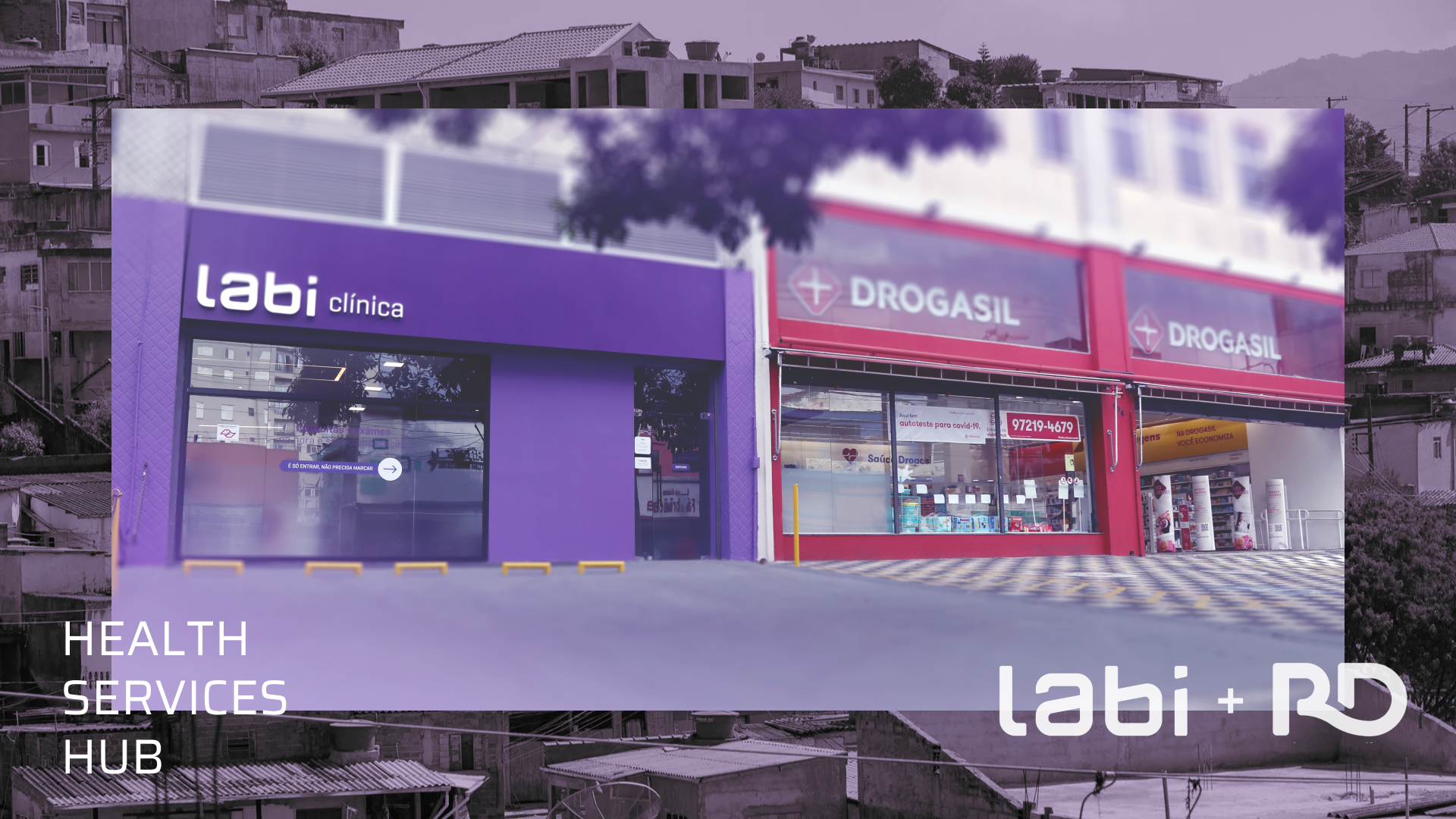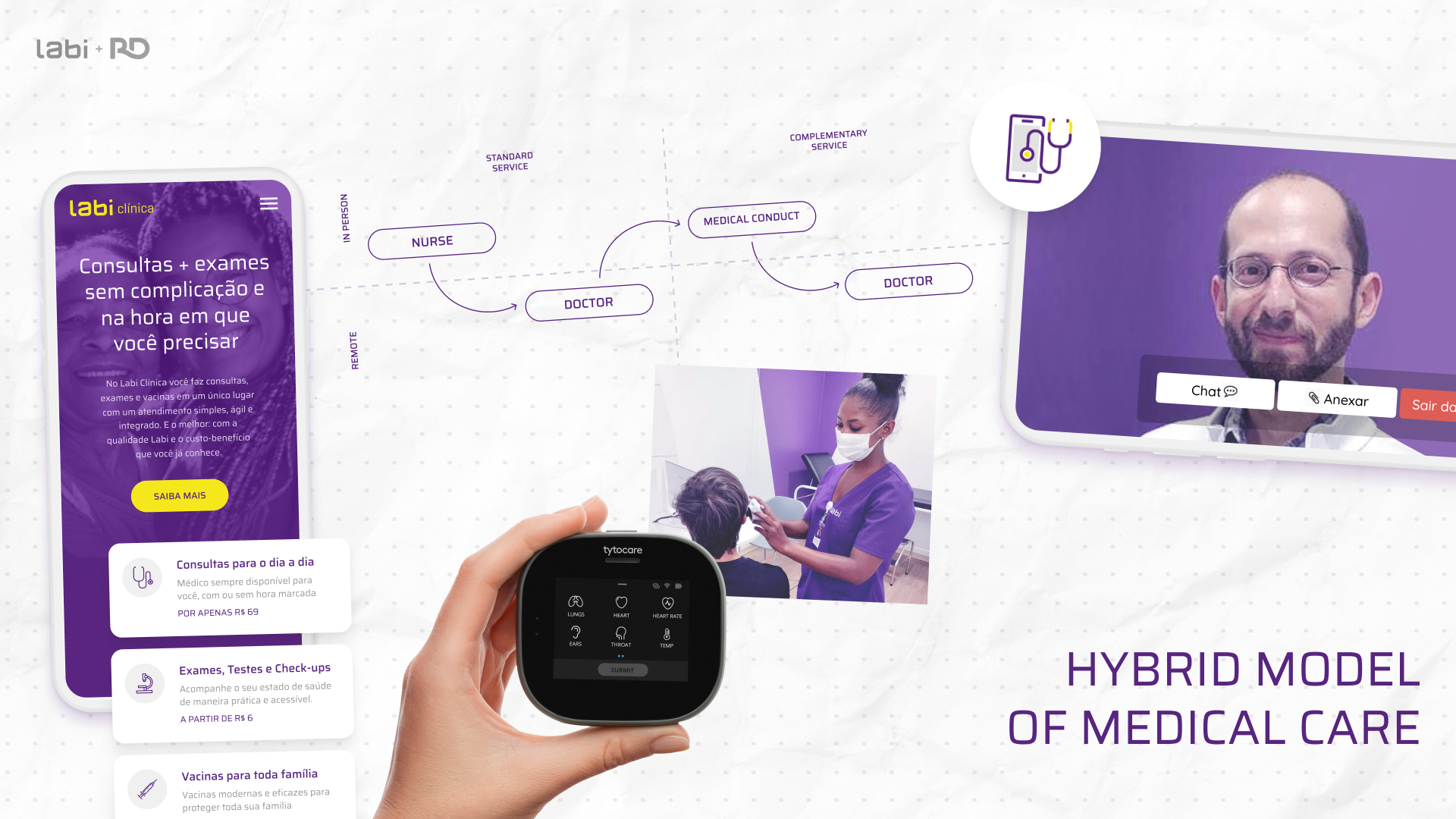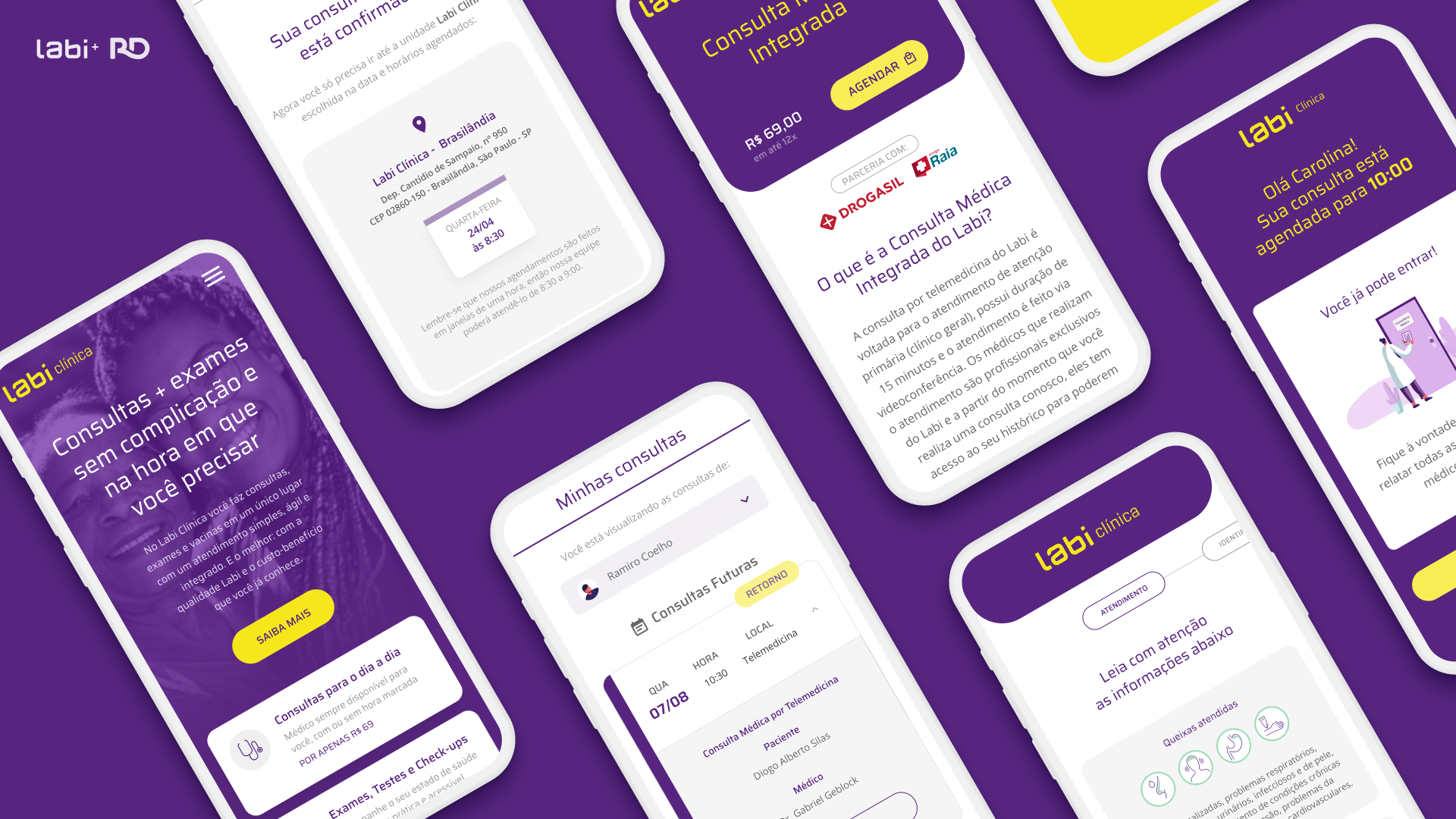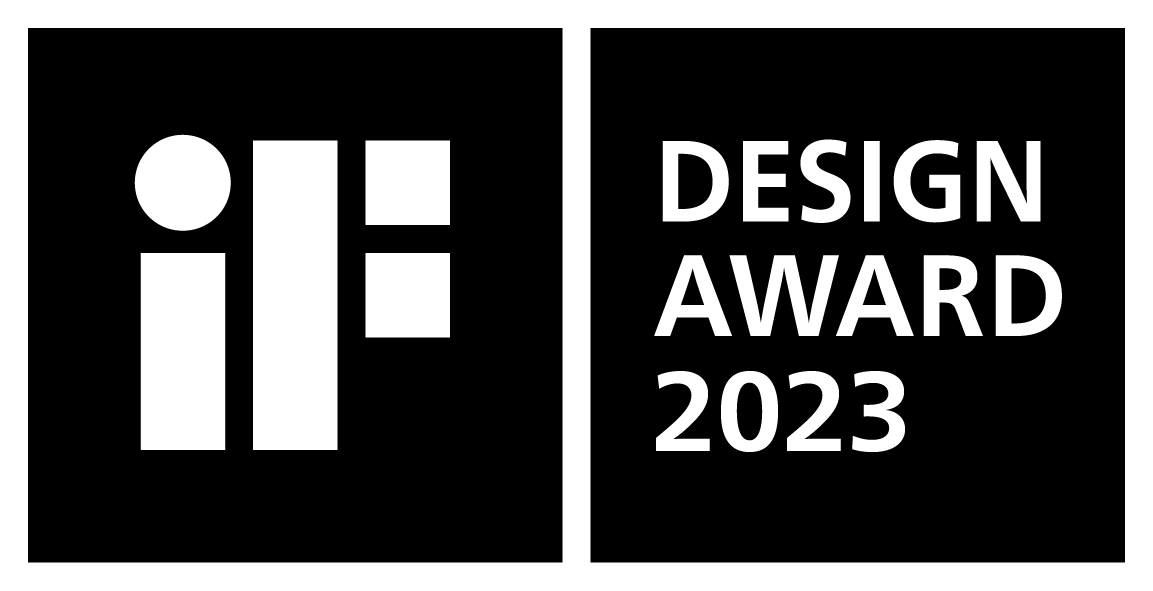Case Study
Expanding the pharmacy journey with a hub of low-cost health services in peripheral areas of São Paulo

Overview
In December 2021, the leading company in the pharmaceutical retail sector in Brazil, incorporated a minority stake in a Brazilian healthtech focused on promoting access to quality clinical analysis tests and vaccines at the best price on the market.
The objective of incorporating this startup into the pharmaceutical network's innovation ecosystem was to seek new business opportunities and expand the health services offered in the group's pharmacies until then.
At the beginning of 2022, as the first initiative resulting from this partnership, the companies jointly launch a popular clinic, which operates next to the drugstore units. In addition to the services already provided by the current healthtech units, such as carrying out laboratory tests, tests, check-ups and the application of vaccines, the new popular clinic units will also offer integrated medical consultations.
Focused on low-complexity emergency care, the integrated medical consultations have a format hitherto unheard of in the country, which brings the care of a health team made up of nurses present on site and doctors, who will assist patients via telemarketing, for the price of only BRL 69.
Deliverables
Product Strategy
Product Roadmap
Digital Product Design
Guidelines for Architectural Project
Service Protocols and Playbooks
Outcomes
87
9.6
3k+
services performed during the MVP
4
Design Awards achieved
Customer Satisfaction Score
Net Promoter Score
Recognition
& Awards
Finalist, iF Design Award 2024, Service Design. READ MORE
Winner, Design for a Better World Award 2022, Service Design. READ MORE
Bronze, Brasil Design Award 2022, Service Design. READ MORE
Winner, Prêmio Bornancini 2022, Service and Strategic Design. READ MORE
"Raia Drogasil will have a clinic "glued" to its pharmacies" READ MORE
"Labi Exames will open health clinics next to Raia Drogasil pharmacies”
READ MORE
"Raia Drogasil invests in Labi and enters laboratory tests" READ MORE
"Labi Exames and Raia Drogasil create centers of health services” READ MORE
"Labi Exames e Raia Drogasil criam polos de serviços de saúde, com clínicas e farmácias lado a lado” READ MORE
01.
The approach
Discovery Strategy
The project was led by Labi's Product & Experience team in partnership with the RD's Customer Experience team and connected several partners throughout the discovery and delivery processes. The strategy started with making a discovery based on understanding the journeys of the main stakeholders in the Brazilian scenario, understanding the current scenario of innovative initiatives in the context of primary care around the world and, finally, understanding the regulatory opportunities and limitations based on from the point of view of health managers in the public and private markets in Brazil.
Collecting Information
The surveys started with an up-to-date portrait of healthcare journeys from the point of view of patients and physicians. In order to understand the current scenario of the relationship between physicians and patients, a field survey was carried out, which included in-depth interviews with 12 physicians and 12 patients from different regions of the country. The result of this research was the identification of 4 patient personas (Jalecophobia, Procastinator, Past Teach and Investing in the Future) and 3 physician personas (Dr. Mission, Excellence & Career, People Person). These personas helped to make the public clusters tangible and served as the basis for the unfolding of the health care journeys from the point of view of each of the 7 personas.
Next, a desk research was carried out, which mapped the state of the art in primary health care, with details in cases of the public sector, such as the unified Brazilian health service (SUS), considered an international reference in basic health, and also in private sector cases such as the primary care services offered by large pharmaceutical retail chains in North America and Europe. The outputs of this stage included the construction of small dossiers, comparative tables and flowcharts of each of the analyzed services, all of this accompanied by interpretative analyzes in relation to the particularities of the different contexts considered.
Finally, an immersion was carried out with physicians responsible for public and private health management organizations focused on primary care. This immersion included a series of interviews and document analyses. This step was fundamental for understanding the technical and regulatory limitations present in the current scenario of the segment in the country. The results of this immersion were made tangible in the form of ecosystem mappings and the relationship between the main stakeholders involved. In addition, a series of in-depth opinions were generated in relation to different specific stages of the service, such as legal issues, technology available for recording medical data, care in relation to the protection of patients' health data, among others.
Defining Value
After the discovery stage, a multidisciplinary team composed of professionals from the areas of health, business, design, architecture and engineering dedicated themselves to analyzing the pain points and opportunities identified from the survey outputs. This analysis allowed a framing of the initial problem and the definition of the area of action of the solution that would be proposed. The definition of the solution area was based on the construction of the value proposal map and the consequent definition of the service offer map, which prioritized products directly related to primary care and of low execution complexity due to the timing of the launch of the project.
This multidisciplinary team gradually made the value proposition of the new service tangible, from the more conceptual aspects such as the technical approach that would be adopted within the health area to more objective aspects such as the flows that would be followed within the service and the physical space where this experience would take place for the client. All this took place in a series of practical work meetings carried out with different working groups formed from the combination of the different backgrounds of the specialists present in the team.
The result
02.
Delivery Strategy
With the value proposition clear to all stakeholders in the discovery phase, design professionals moved on to materialize the service for the end user. In this sense, the first implementation of delivery was the construction of the blueprint of the service, which covered all the technical aspects of delivering the service to the final patient, including operational processes for the service team, medical team and IT team, in addition to all the other support areas indirectly related to the day-to-day maintenance of a physical health care unit, such as maintenance, cleaning and warehouse.
The next step was to land the flow in the physical environment. An architecture professional and an engineering professional joined the design team to design the unit's environment from scratch, considering everything from the choice of physical locations for location to the design of space, furniture and unit signage. The architectural project used the premises established in the experience story canvas, which is a tool that crosses flows of people fulfilling tasks in a physical environment, crossing each of the stages with the spaces where they take place and the tech enablers involved in each interaction.
Still as a delivery deployment, the medical team deployed a series of documents recording the health care protocols. Among the documents constructed were the unit's standard operating procedures, medical care playbooks and nursing care protocols, which would serve as guides for triage with the face-to-face team and preparation for medical care that would take place at a distance.
Validation
Once the journey as a whole was designed, as well as the prototypes of the main points of contact, the next step was to validate the solution with potential customers. This stage comprises two main actions: validating the value proposition and validating the initial interaction for service consumption. The first validation involved 4 discussion sessions in the format of focus groups, each composed of 5 participants with profiles that emulated the patient personas identified in the initial research. While the second validation occurred with the application of a usability test carried out in person with 12 customers of the brand who were leaving one of the healthtech units after performing a laboratory service.
The focus group sessions for validation of the value proposition served to validate the fit of the service that was being built with the intended target audience. It was clear that the low cost attribute was the great positive highlight, while the issue of the hybrid format was mentioned as a possible concern, even though the interviewees were willing to do a first test, since the general cost benefit still presented a positive balance to overcome an initial barrier of distrust. The usability test validated the proposed convenience made tangible in a flow that allowed access to appointments both with prior appointment and without appointment for the public with spontaneous demands that was close to the unit. Despite the success in carrying out the tasks, several points of reinforcement for possible doubts were mapped from the oral interactions of the participants when carrying out the tests in person.
Executing the plan
For the implementation of the first units of the project, the neighborhoods of Grajaú and Brasilândia, in the South and North Zones of São Paulo, respectively, were chosen. The idea is to bring quality healthcare at an affordable price to regions further away from the center and with a higher concentration of people without health insurance. Currently in Brazil, the number of people covered by health insurance is only 28% and this percentage is even lower in the peripheral regions of large centers. The challenge of depending exclusively on the public health system in places like Brasilândia and Grajaú includes a routine of long waits for care and frequent absences of health professionals for scheduled medical appointments.
As it is a primary care service, the clinic only deals with day-to-day health issues, which represent about 95% of complaints in a community according to classic studies of family and community medicine. The list of complaints attended includes localized pain, respiratory, gastrointestinal, urinary, infectious and skin problems. Monitoring of chronic conditions such as diabetes, hypertension, thyroid problems, asthma and cardiovascular disease is also available.
The impact
03.
Discovery Strategy
As the units were inaugurated, the design team closely monitored the project's indicators, evaluating all the operating data available by default (such as number of visits, type of service, NPS of the unit, etc.) of the customer experience. This evaluation was carried out through active contacts with one hundred percent of the patients who went through the new integrated consultation product, since the other laboratory services (exams, tests, check-ups and vaccines) are part of the company's core business and already has high standards of satisfaction.
In active contact with patients, approximately 200 people were interviewed and questions such as: satisfaction with each of the care stages, such as care at the reception, care provided by the nursing team and care provided by the technical team; overall service satisfaction and achievement of expectations regarding the initial service offering. In all aspects, the evaluations were very positive, highlighting the general NPS of the service of 89 and the CSAT of the health team, which was in the range of 9.7 for both nurses and physicians. In addition, the rate of resolution of consultations was at the level of 90% in relation to the complaints presented by patients, which confirms data from theoretical and market studies regarding the efficiency of the role of the family doctor in primary care.
With regard to the evaluation aspects of the quality of the design itself, the project underwent a series of peer reviews and received recognition from technical juries in several national and international design and innovation awards, such as:
Design for a Better World 2022 - Design Category Winner
Brazil Design Award 2022 - Bronze in the Service Design Category
Prêmio Bornancini 2022 - Gold in the Strategic or Service Design Category
iF Design Award 2024 - Shortlisted for Final Jury
Outputs & Outcomes
From the point of view of the organizations, the project was considered a successful case in integrating operations of different companies in the innovation ecosystem of the pharmaceutical group and allowed the investee startup to stand out in the planning of actions for the following year. The initial objective of promoting synergies by expanding health services offered in pharmacies had evaluations with different perceptions. On the one hand, the expectation was that the pharmacy would be the main generator of demand for the clinic, but this trigger had different performances from unit to unit, depending on the particularities of each region in relation to the public and the offer of free public health. In contrast, having a pharmacy next to the clinic was something highly valued by service users who perceived this as a convenience factor and, to a certain extent, credibility for the service they were consuming, due to the weight of the pharmaceutical brand. in endorsing the partnership with the clinic.





Reflections
04.
Learnings & Take Aways
From the point of view of the designers involved in the project, there was a consensus regarding the difficulty of working with the expectations of the stakeholders about the deployment of innovation in health in the national territory in comparison to the historical state of the art executed in references of the international market. It was necessary to deconstruct the initial idea that something that worked in completely different markets like Mexico and the United Kingdom could be replicated ipsis literalis in the Brazilian context. Factors such as professional maturity, government regulation, access to basic services and concern for privacy are key to understanding the success of projects of this type in certain regions.
When we talk about the Brazilian scenario, in addition to all the social difficulties already mentioned above in relation to public access to health services, there is also a determining role of class organizations in relation to what is or is not possible to be done in terms of innovation . Innovating in the medical field in Brazil is often stumbling upon the dividing line between what is regulated and what is subject to punishment by professional councils and government agencies such as health surveillance. However, recent events such as the COVID-19 pandemic have shown us that it is necessary to push these regulatory limits to promote a greater reach of the medical service and consequently increase the health and well-being of the population as a whole, always focusing on the common good.
On the side of the companies involved, the project fulfilled its role as a pilot by validating the value proposition and the fit with the market on a controllable scale. Healthtech was able to give the necessary pace to test the model in a short period of time, emulating the conditions for replication on a national scale as much as possible. The 12-month period of running the pilot was the time needed to validate the service and also confirm the regulatory evolutions that allowed the pharmaceutical retail group to decide to internalize 100% of the physical operation, using the healthtech team only as a provider of the backstage service. In March 2023, the first pharmacies in the group started operating the integrated consultation service presented in this case, under the new name of teleinterconsultation in the pharmacy.












